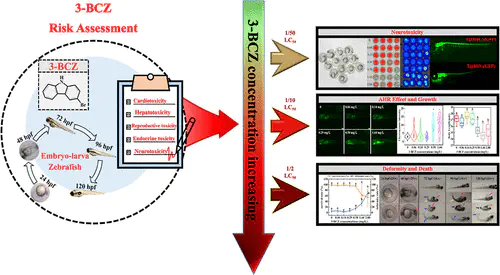3-Bromocarbazole-induced Developmental Neurotoxicity and Effect Mechanisms in Zebrafish

Abstract
Polyhalogenated carbazoles (PHCZs) are dioxin-like emerging contaminants, but limited information exists on their neurotoxicity and mechanisms. This study employed zebrafish embryos to investigate the adverse effects of 3-bromocarbazole (3-BCZ), a typical PHCZ, exposure in their early life stages and found that the 120 h post fertilization (hpf)-median lethal concentration (LC50) value of 3-BCZ in zebrafish larvae was 2.88 mg/L. The results revealed that 3-BCZ inhibited tail coiling at ≥0.06 mg/L, decreased hatchability at ≥2.88 mg/L, increased mortality and malformation rates at ≥1.44 mg/L, induced aryl hydrocarbon receptor effects and reduced body length at ≥0.58 mg/L, and inhibited behavior activities at ≥0.06 mg/L. Further mechanism investigations showed that 3-BCZ exposures repressed the motor neuron axon length via downregulating the mRNA transcription levels of α1-tubulin, Gap43, Syn2a, and shha, and decreased central nervous system neurogenesis via downregulating the mRNA transcription levels of elavl3, nrd, mbp, and gfap. Overall, 3-BCZ induces developmental neurotoxicity in zebrafish larvae at 0.06 mg/L (1/50 LC50). Tail coiling activity at 24 hpf and swimming total distance at 120 hpf could be ideal indicators of 3-BCZ health risks in zebrafish. These findings provide valuable insights for health and ecological risk assessments of 3-BCZ and other PHCZs.